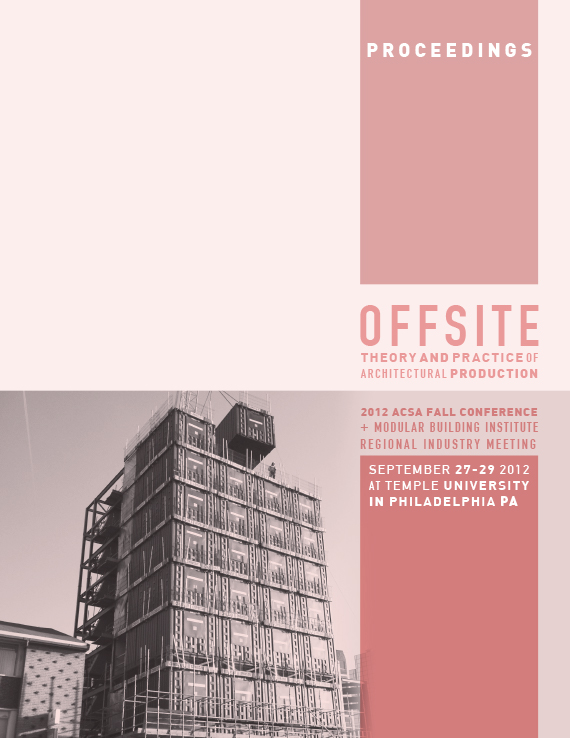Author(s): Joshua Bard & Matthew Schulte
Both in practice and academia it is often the case that design and constructionare considered two distinct and separate phases of any project’s realization.This is both ideologically and contractually supported by current pedagogicaland practice models. Acknowledging that modes of operation shift during theprocess of realizing any project is essential. But, it is no longer a valid assumptionthat design is a separate act from that of construction and vice versa. Thisis especially true as the relationship between design intent and the mechanismsfor achieving building performance become increasingly inseparable.Emerging technologies aimed at grappling with the dramatic increase in buildingsophistication and the need for open collaboration increasingly positiondigital proxies, digital fabrication tools and by extension prefabrication, underthe direction of the architect.What began in the fall of 2010 as a speculative conversation with the directorof Hostel Detroit, a non-profit youth hostel located in the re-emerging Corktownneighborhood of southwest Detroit quickly took shape in a graduate leveldesign-build seminar during the spring of 2011 that was designed to exploreand confront the apparent divide between design and construction throughdigital practice. During a short 8-week term, students were pushed to workdirectly through 3d digital modeling and CNC (Computer Numerical Control)fabrication techniques to design, develop, prototype and fabricate a structureto house multiple overlapping programs. The “super-shed” was to provide securebicycle and equipment storage, a covered gathering and socializing spaceand to function as a rainwater collection device supporting a series of smallscale organic gardens.The course emphasized CNC prototyping and prefabrication as a means ofdeveloping collaboration, craft, efficiency, tolerance and control. Further, itrequired students to be cognizant of the realities of strict budgetary and schedulingrequirements, materials and processes, structural criteria as well as thelogistics of transport and erection.Because the course focused on CNC prototyping and prefabrication, repeatedexposure to digital making heavily influenced the coursework and learning.Fluency through digital practice allowed the scope of the endeavor to increasein scale and complexity. Students leveraged skill in parametric digital modelingto fluidly connect design intent to fabrication. A parametric model developedearly in the term was repeatedly refined and revised in an evolving feedbackloop with prototyping and design evolution. The structural module, whichin this case was a triangulated framework of custom water-jet cut steel gussetsand standard dimensional lumber, allowed the units to move quickly from adigital environment into fabrication as a kit of parts which were transported tothe site for rapid erection with simple hand tools. Complimentary assembliesfor the cladding and structural deck also evolved within the parametric model.Embedded within these components were a series of machined reliefs andchannels which located an integrated set of custom designed and prefabricatedbike racks and movable door panels.The course demonstrates the unique educational experience that grows fromdigital approaches to design thinking and full-scale rapid prototyping in making(and remaking) the project throughout the term.
Volume Editors
John Quale, Rashida Ng & Ryan E. Smith
ISBN
978-0-935502-85-5

 Study Architecture
Study Architecture  ProPEL
ProPEL 
